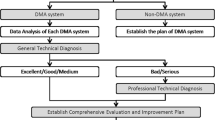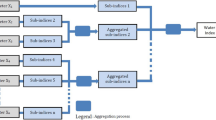Abstract
Water quality monitoring is a complex issue that requires support tools in order to provide information for water resource management. Budget constraints as well as an inadequate water quality network design call for the development of evaluation tools to provide efficient water quality monitoring. For this purpose, a nonlinear principal component analysis (NLPCA) based on an autoassociative neural network was performed to assess the redundancy of the parameters and monitoring locations of the water quality network in the Piabanha River watershed. Oftentimes, a small number of variables contain the most relevant information, while the others add little or no interpretation to the variability of water quality. Principal component analysis (PCA) is widely used for this purpose. However, conventional PCA is not able to capture the nonlinearities of water quality data, while neural networks can represent those nonlinear relationships. The results presented in this work demonstrate that NLPCA performs better than PCA in the reconstruction of the water quality data of Piabanha watershed, explaining most of data variance. From the results of NLPCA, the most relevant water quality parameter is fecal coliforms (FCs) and the least relevant is chemical oxygen demand (COD). Regarding the monitoring locations, the most relevant is Poço Tarzan (PT) and the least is Parque Petrópolis (PP).



Similar content being viewed by others
References
Abdi, H., Valentin, D., & Edelman, B. (1999). Neural networks. Series: Quantitative Applications in the Social Sciences Sage Publications Papers.
APHA. (2005). Standard methods for the examination of water and wastewater (21st ed.). New York: American Public Health Association.
Brazilian Institute of Geography and Statistics – IBGE. (2013). Census Atlas/IBGE (p. 2013, 156). Rio de Janeiro: IBGE.
Cattell, R. B. (1966). The scree test for the number of factors. Multiv Behav Res, 1, 245–276.
Cetinkaya, P., & Harmancioglu, N. B. (2012). Assessment of water quality sampling sites by a dynamic programming approach. Journal of Hydrology. Eng, 17, 305–317.
Cohen, J. (1988). Statistical power analysis for the behavioral sciences (2nd ed.). Hillsdale, NJ: Lawrence Erlbaum Associates.
Giri, S., & Qiu, Z. (2016). Understanding the relationship of land uses and water quality in twenty first century: a review. Journal Environmental Monitoring, 173, 14–48.
Hair Jr., J. F., Black, W. C., Babin, B. J., & Anderson, R. E. (2009). Multivariate data analysis (7th ed.). Prentice Hall.
Han, J., Kamber, M., & Pei, J. (2011). Data mining: concepts and techniques (3rd ed.). Morgan Kaufmann.
Harmancioglu, N. B., & Alpaslan, N. (1992). Water quality monitoring network design a problem of multi-objetive decision making. Journal of the American Water Resources Association, 28, 179–192.
Horowitz, A. J. (2013). A review of selected inorganic surface water quality-monitoring practices: are we really measuring what we think, and if so, are we doing it right? Environmental. Science. Technology., 2013(47), 2471–2486.
Howes, P., & Crook, N. (1999). Using input parameter influences to support the decisions of feedforward neural networks. Neurocomputing, 24(1–3), 191–206.
Hsieh, W. W. (2007). Nonlinear principal component analysis of noisy data. Neural Networks, 20, 434–443.
Jolliffe, I. T. (2002). Principal component analysis. 2: Springer.
Kaiser, H. F. (1960). The application of electronic computers to factor analysis. Educational and Psychological Measurement, 20, 141–151.
Khalil, B., & Ouarda, T. B. M. J. (2009). Statistical approaches used to assess and redesign surface water-quality-monitoring networks. Journal Environmental Monitoring, 11, 1915–1929.
Kramer, M. A. (1991). Nonlinear principal component analysis using autoassociative neural networks. AICHE Journal, 37, 233–243.
Lee, C., Paik, K., Yoo, D. G., & Kim, J. H. (2014). Efficient method for optimal placing of water quality monitoring stations for an ungauged basin. Journal of Environmental Management, 132, 24–31.
Lettenmaier, D. P., Anderson, D. E., & Brenner, R. N. (1984). Consolidation of a stream quality monitoring network. Water Resources Bulletin, 20, 473–481.
Lu, B. W., & Pandolfo, L. (2011). Quasi-objective nonlinear principal component analysis. Neural Networks, 24, 159–170.
MacKay, D. J. C. (1992). Bayesian interpolation. Neural Computation, 3, 415–447.
Mahjouri, N., & Kerachian, R. (2011). Revising river water quality monitoring networks using discrete entropy theory: the Jajrood River experience. Environmental Monitoring and Assessment., 175, 291–302.
Maier, H. R., Jain, A., Dandy, G. C., & Sudheer, K. P. (2010). Methods used for the development of neural networks for the prediction of water resource variables in river systems: current status and future directions. Environmental Modelling & Software, 25, 891–909.
McBride, G. B. (2005). Using statistical methods for water quality management: issues, problems and solutions (1st ed.). Wiley Interscience.
Mirgolbabaei, H., Echekkia, T., & Smaoui, N. (2014). A nonlinear principal component analysis approach for turbulent combustion composition space. International Journal of Hydrogen Energy, 39, 4622–4633.
Monahan, A. H. (2000). Nonlinear principal component analysis by neural networks: theory ana application to the Lorenz system. Journal of Climate, 13(4), 821–835.
National [Brazilian] Water Agency – ANA (2012). Picture of the surface water quality of Brazil: National Water Agency. Brasília, DF: ANA.
Newbigging, S. C., Mysak, L. A., & Hsieh, W. W. (2000). Improvements to the non-linear principal component analysis method, with applications to ENSO and QBO. Atmosphere–ocean, 41, 291–299.
Nguyen, D., & Widrow, B. (1990). Improving the learning speed of 2-layer neural networks by choosing initial values of the adaptive weights. Proceedings of the International Joint Conference on Neural Networks, 3, 21–26.
Ogwueleka, T. C. (2015). Use of multivariate statistical techniques for the evaluation of temporal and spatial variations in water quality of the Kaduna River, Nigeria. Environmental Monitoring and Assessment, 187, 1–17.
Olsen, R. L., Chappell, R. W., & Loftis, J. C. (2012). Water quality sample collection, data treatment and results presentation for principal components analysis—literature review and Illinois River watershed case study. Water Research, 46, 3110–3122.
Ouyang, Y. (2005). Evaluation of river water quality monitoring stations by principal component analysis. Water Research, 39, 2621–2635.
Ouyang, Y., Nkedi-Kizza, P., Wu, Q. T., Shinde, D., & Huang, C. H. (2006). Assessment of seasonal variations in surface water quality. Water Research, 40, 3800–3810.
Papadokonstantakis, S., Lygeros, A., & Jacobsson, S. P. (2006). Comparison of recent methods for inference of variable influence in neural networks. Neural Networks, 19, 500–513.
Phung, D., Huang, C., Rutherford, S., Dwirahmadi, F., Chu, C., Wang, X., Nguyen, M., Nguyen, N. H., Do, C. M., Nguyen, T. H., & Dinh, T. A. D. (2015). Temporal and spatial assessment of river surface water quality using multivariate statistical techniques: a study in Can Tho City, a Mekong Delta area, Vietnam. Environmental Monitoring and Assessment, 187, 229–241.
Razavi, T., & Coulibal, P. (2013). Classification of Ontario watersheds based on physical attributes and streamflow series. Journal of Hydrology, 493, 81–94.
Razmkhah, H., Abrishamchi, A., & Torkian, A. (2010). Evaluation of spatial and temporal variation in water quality by pattern recognition techniques: a case study on Jajrood River (Tehran, Iran). Journal of Environmental Management, 91, 852–860.
Resino, S., Seoane, J.A., Bellon, J.M, Dorado, J., Sanches-Martin, F., Alvarez, E., Cosin, J., Lopez, J. C., Lopez, G., Miralles, P,, Berenguer, J. (2011). An artificial neural network improves the non-ivasive diagnosis of significant fibrosis in HIV/HCV coinfected patients. Journal of Infection, 62, 77–86.
Scholkopf, B., Smola, A., & Muller, K. R. (1998). Nonlinear component analysis as a kernel eigenvalue problem. Neural Computation, 10, 1299–1319.
Selle, B., Schwientek, M., & Lischeid, G. (2013). Understanding processes governing water quality in catchments using principal component scores. Journal of Hydrology, 486, 31–38.
Sharp, W. E. (1971). A topologically optimum water-sampling plan for rivers and streams. Water Resources Research, 7, 1641–1646.
Shrestha, S., & Kazama, F. (2007). Assessment of surface water quality using multivariate statistical techniques: a case study of the Fuji river basin. Japan. Environmental Modelling & Software., 22, 464–475.
Simeonov, V., Stratisb, J. A., Samarac, C., Zachariadisb, G., Voutsac, D., Anthemidis, A., Sofonioub, M., & Kouimtzis, T. (2003). Assessment of the surface water quality in northern Greece. Water Research, 37, 4119–4124.
Singh, K. P., Malik, A., Mohan, D., & Sinha, S. (2004). Multivariate statistical techniques for the evaluation of spatial and temporal variations in water quality of Gomti River (India)—a case study. Water Research, 38, 3980–3992.
Singhal, A., & Salsbury, T. I. (2005). A simple method for detecting valve stiction in oscillating control loops. Journal of Process Control, 15, 371–382.
Strobl, R. O., & Robillardb, P. D. (2008). Network design for water quality monitoring of surface freshwaters: a review. Journal of Environmental Management, 87, 639–648.
Tanos, P., Kovács, J., Kovács, S., Anda, A., & Hatvani, I. G. (2015). Optimization of the monitoring network on the river Tisza (Central Europe, Hungary) using combined cluster and discriminant analysis, taking seasonality into account. Environmental Monitoring and Assessment, 187, 575–589.
Tenenbaum, J. B., de Silva, V., & Langford, J. C. (2000). A global geometric framework for nonlinear dimensionality reduction. Science, 290, 2319–2323.
Theodoris, S., & Koutroumbas, K. (2009). Pattern regognition (4a ed.). Academic Press.
USEPA (2009). 2009 - Guidance for Data Quality Assessment Practical Methods for Data Analysis EPA QA/G-9 QA00 UPDATE. Washington, DC: Office of Environmental Information, U.S. Environmental Protection Agency.
Vega, M., Pardo, R., Barrado, E., & Debán, L. (1998). Assessment of seasonal and polluting effects on the quality of river water by exploratory data analysis. Water Research, 32, 3581–3592.
Wang, X., Cai, Q., Ye, L., & Qu. (2012). Evaluation of spatial and temporal variation in stream water quality by multivariate statistical techniques: a case study of the Xiangxi River basin, China. Quaternary International, 282, 137–144.
Wang, Y. B., Liu, C. W., Liao, P. Y., & Lee, J. J. (2014). Spatial pattern assessment of river water quality: implications of reducing the number of monitoring stations and chemical parameters. Environmental Monitoring and Assessment, 186, 1781–1792.
Ward, R. C. (1996). Water quality monitoring: where’s the beef? Journal of the American Water Resources Association, 32, 673–680.
Ward, R. C., Loftis, J. C., & McBride, G. B. (1990). Design of water quality monitoring systems. Van Nostrand Reinhold, New York, NY, 231 p.
Zobel, C. W., & Cook, D. F. (2011). Evaluation of neural network variable influence measures for process control. Engineering Applications of Artificial Intelligence, 24, 803–812.
Acknowledgements
This work was funded by the Geological Survey of Brazil (CPRM), MCT/FINEP/CT-HIDRO, and Coordination of Higher Education Personnel Improvement-CAPES—Brazil (MEC/MCTI/CAPES/CNPq). The authors would like to thank CPRM EIBEX project team, especially Achiles Monteiro (in memoriam), for all the support and the anonymous reviewers whose comments brought to the author’s attention points that were unclear in the original draft.
Author information
Authors and Affiliations
Corresponding author
Rights and permissions
About this article
Cite this article
Villas-Boas, M.D., Olivera, F. & de Azevedo, J.P.S. Assessment of the water quality monitoring network of the Piabanha River experimental watersheds in Rio de Janeiro, Brazil, using autoassociative neural networks. Environ Monit Assess 189, 439 (2017). https://doi.org/10.1007/s10661-017-6134-9
Received:
Accepted:
Published:
DOI: https://doi.org/10.1007/s10661-017-6134-9




